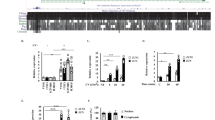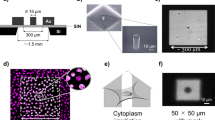Abstract
Exposure of human cells to genotoxic agents induces various signaling pathways involved in the execution of stress- and DNA-damage responses. Inappropriate functioning of the DNA-damage response to ionizing radiation (IR) is associated with the human diseases ataxia-telangiectasia (A-T) and Nijmegen Breakage syndrome (NBS). Here, we show that IR efficiently induces Jun/ATF transcription factor activity in normal human diploid fibroblasts, but not in fibroblasts derived from A-T and NBS patients. IR was found to enhance the expression of c-Jun and, in particular, ATF3, but, in contrast to various other stress stimuli, did not induce the expression of c-Fos. Using specific inhibitors, we found that the ATM- and Nibrin1-dependent activation of ATF3 does neither require p53 nor reactive oxygen species, but is dependent on the p38 and JNK MAPkinases. Via these kinases, IR activates ATF-2, one of the transcription factors acting on the atf3 promoter. The activation of ATF-2 by IR resembles ATF-2 activation by certain growth factors, since IR mainly induced the second step of ATF-2 phosphorylation via the stress-inducible MAPkinases, phosphorylation of Thr69. As IR does not enhance ATF-2 phosphorylation in ATM and Nibrin1-deficient cells, both ATF-2 and ATF3 seem to play an important role in the protective response of human cells to IR.
This is a preview of subscription content, access via your institution
Access options
Subscribe to this journal
Receive 50 print issues and online access
$259.00 per year
only $5.18 per issue
Buy this article
- Purchase on Springer Link
- Instant access to full article PDF
Prices may be subject to local taxes which are calculated during checkout







Similar content being viewed by others
References
Abraham RT . (2001). Genes Dev., 15, 2177–2196.
Allan AL, Albanese C, Pestell RG and LaMarre J . (2001). J. Biol. Chem., 276, 27272–27280.
Amundson SA, Bittner M, Chen Y, Trent J, Meltzer P and Fornace Jr AJ . (1999). Oncogene, 18, 3666–3672.
Bar-Shira A, Rashi-Elkeles S, Zlochover L, Moyal L, Smorodinsky NI, Seger R and Shiloh Y . (2002). Oncogene, 21, 849–855.
Bennett BL, Sasaki DT, Murray BW, O'Leary EC, Sakata ST, Xu W, Leisten JC, Motiwala A, Pierce S, Satoh Y, Bhagwat SS, Manning AM and Anderson DW . (2001). Proc. Natl. Acad. Sci. USA, 98, 13681–13686.
Buscemi G, Savio C, Zannini L, Micciche F, Masnada D, Nakanishi M, Tauchi H, Komatsu K, Mizutani S, Khanna K, Chen P, Concannon P, Chessa L and Delia D . (2001). Mol. Cell. Biol., 21, 5214–5222.
Cai Y, Zhang C, Nawa T, Aso T, Tanaka M, Oshiro S, Ichijo H and Kitajima S . (2000). Blood, 96, 2140–2148.
Coffer PJ, Burgering BM, Peppelenbosch MP, Bos JL and Kruijer W . (1995). Oncogene, 11, 561–569.
Cuenda A, Rouse J, Doza YN, Meier R, Cohen P, Gallagher TF, Young PR and Lee JC . (1995). FEBS Lett., 364, 229–233.
Devary Y, Gottlieb RA, Smeal T and Karin M . (1992). Cell, 71, 1081–1091.
Devary Y, Rosette C, DiDonato JA and Karin M . (1993). Science, 261, 1442–1445.
el-Deiry WS, Harper JW, O'Connor PM, Velculescu VE, Canman CE, Jackman J, Pietenpol JA, Burrell M, Hill DE, Wang Y, Wiman KG, Edward Mercer W, Kastan MB, Kohn KW, Elledge SJ, Kinzler KW and Vogelstein B . (1994). Cancer Res., 54, 1169–1174.
Girard PM, Riballo E, Begg AC, Waugh A and Jeggo PA . (2002). Oncogene, 21, 4191–4199.
Gross S, Knebel A, Tenev T, Neininger A, Gaestel M, Herrlich P and Bohmer FD . (1999). J. Biol. Chem., 274, 26378–26386.
Gupta S, Campbell D, Derijard B and Davis RJ . (1995). Science, 267, 389–393.
Haas S and Kaina B . (1995). Carcinogenesis, 16, 985–991.
Hai T, Wolfgang CD, Marsee DK, Allen AE and Sivaprasad U . (1999). Gene Expr., 7, 321–335.
Hsu JC, Bravo R and Taub R . (1992). Mol. Cell. Biol., 12, 4654–4665.
Jaspers NGJ, Gatti RA, Baan C, Linssen PCML and Bootsma D . (1988). Cytogenet. Cell. Genet., 49, 259–263.
Jongmans W, Vuillaume M, Chrzanowska K, Smeets D, Sperling K and Hall J . (1997). Mol. Cell. Biol., 17, 5016–5022.
Kastan MB, Zhan Q, el-Deiry WS, Carrier F, Jacks T, Walsh WV, Plunkett BS, Vogelstein B and Fornace Jr. AJ . (1992). Cell, 71, 587–597.
Kawasaki H, Schiltz L, Chiu R, Itakura K, Taira K, Nakatani Y and Yokoyama KK . (2000). Nature, 405, 195–200.
Khanna KK, Beamish H, Yan J, Hobson K, William R, Dunn I and Lavin MF . (1995). Oncogene, 11, 609–618.
Kim ST, Xu B and Kastan MB . (2002). Genes Dev., 16, 560–570.
Klein B, Pastink A, Odijk H, Westerveld A and van der Eb AJ . (1990). Exp. Cell. Res., 191, 256–262.
Knebel A, Rahmsdorf HJ, Ullrich A and Herrlich P . (1996). EMBO J., 15, 5314–5325.
Lim DS, Kim ST, Xu B, Maser RS, Lin J, Petrini JH and Kastan MB . (2000). Nature, 404, 613–617.
Liu ZG, Baskaran R, Lea-Chou ET, Wood LD, Chen Y, Karin M and Wang JY . (1996). Nature, 384, 273–276.
Livingstone C, Patel G and Jones N . (1995). EMBO J., 14, 1785–1797.
Mashima T, Udagawa S and Tsuruo T . (2001). J. Cell. Physiol., 188, 352–358.
Mercurio F and Manning AM . (1999). Oncogene, 18, 6163–6171.
Ouwens DM, de Ruiter ND, van der Zon GC, Carter AP, Schouten J, van der Burgt C, Kooistra K, Bos JL, Maassen JA and van Dam H . (2002). EMBO J., 21, 3782–3793.
Perez S, Vial E, van Dam H and Castellazzi M . (2001). Oncogene, 20, 1135–1141.
Pfeiffer P, Gottlich B, Reichenberger S, Feldmann E, Daza P, Ward JF, Milligan JR, Mullenders LH and Natarajan AT . (1996). Mutat. Res., 366, 69–80.
Ronai Z, Yang YM, Fuchs SY, Adler V, Sardana M and Herlyn M . (1998). Oncogene, 16, 523–531.
Rosette C and Karin M . (1996). Science, 274, 1194–1197.
Rotman G and Shiloh Y . (1999). Oncogene, 18, 6135–6144.
Sachsenmaier C, Radler-Pohl A, Zinck R, Nordheim A, Herrlich P and Rahmsdorf HJ . (1994). Cell, 78, 963–972.
Schreiber M, Baumann B, Cotten M, Angel P and Wagner EF . (1995). EMBO J., 14, 5338–5349.
Shaulian E and Karin M . (1999). J. Biol. Chem., 274, 29595–29598.
Shaulian E and Karin M . (2001). Oncogene, 20, 2390–2400.
Shaulian E, Schreiber M, Piu F, Beeche M, Wagner EF and Karin M . (2000). Cell, 103, 897–907.
Tamm I, Hand R and Caliguiri LA . (1976). J. Cell. Biol., 69, 229–240.
van Dam H and Castellazzi M . (2001). Oncogene, 20, 2453–2464.
van Dam H, Duyndam M, Rottier R, Bosch A, de Vries-Smits L, Herrlich P, Zantema A, Angel P and van der Eb AJ . (1993). EMBO J., 12, 479–487.
van Dam H, Wilhelm D, Herr I, Steffen A, Herrlich P and Angel P . (1995). EMBO J., 14, 1798–1811.
van Laar T, Steegenga WT, Jochemsen AG, Terleth C and van der Eb AJ . (1995). Biochem. Biophys. Res. Commun., 217, 769–776.
Varon R, Vissinga C, Platzer M, Cerosaletti KM, Chrzanowska KH, Saar K, Beckmann G, Seemanova E, Cooper PR, Nowak NJ, Stumm M, Weemaes CM, Gatti RA, Wilson RK, Digweed M, Rosenthal A, Sperling K, Concannon P and Reis A . (1998). Cell, 93, 467–476.
Wilhelm D, Bender K, Knebel A and Angel P . (1997). Mol. Cell. Biol., 17, 4792–4800.
Wolfgang CD, Liang G, Okamoto Y, Allen AE and Hai T . (2000). J. Biol. Chem., 275, 16865–16870.
Wu X, Ranganathan V, Weisman DS, Heine WF, Ciccone DN, O'Neill TB, Crick KE, Pierce KA, Lane WS, Rathbun G, Livingston DM and Weaver DT . (2000). Nature, 2000, 405, 477–405, 482.
Yamazaki V, Wegner RD and Kirchgessner CU . (1998). Cancer Res., 58, 2316–2322.
Yan C, Wang H and Boyd DD . (2002). J. Biol. Chem., 277, 10804–10812.
Yazdi PT, Wang Y, Zhao S, Patel N and Lee Eyand Qin J . (2002). Genes Dev., 16, 571–582.
Zandomeni R, Mittleman B, Bunick D, Ackerman S and Weinmann R . (1982). Proc. Natl. Acad. Sci. USA, 79, 3167–3170.
Zhao S, Weng YC, Yuan SS, Lin YT, Hsu HC, Lin SC, Gerbino E, Song MH, Zdzienicka MZ, Gatti RA, Shay JW, Ziv Y, Shiloh Y and Lee EY . (2000). Nature, 2000, 405, 473–405, 477.
Zhou BB and Elledge SJ . (2000). Nature, 408, 433–439.
Acknowledgements
We thank Corina van der Burgt and Kim Janssen for their contributions to some of the experiments and Drs DM Ouwens and AG Jochemsen for critically reading the manuscript. This work was supported by grants from the Netherlands Organisation for Scientific Research (NWO), the Dutch Cancer Society (KWF) and the Radiation Protection, Biomed and TMR Programs of the European Community.
Author information
Authors and Affiliations
Corresponding author
Rights and permissions
About this article
Cite this article
Kool, J., Hamdi, M., Cornelissen-Steijger, P. et al. Induction of ATF3 by ionizing radiation is mediated via a signaling pathway that includes ATM, Nibrin1, stress-induced MAPkinases and ATF-2. Oncogene 22, 4235–4242 (2003). https://doi.org/10.1038/sj.onc.1206611
Received:
Revised:
Accepted:
Published:
Issue Date:
DOI: https://doi.org/10.1038/sj.onc.1206611
Keywords
This article is cited by
-
Competitive ubiquitination activates the tumor suppressor p53
Cell Death & Differentiation (2020)
-
Atf3 deficiency promotes genome instability and spontaneous tumorigenesis in mice
Oncogene (2018)
-
Ku70 Serine 155 mediates Aurora B inhibition and activation of the DNA damage response
Scientific Reports (2016)
-
Sensitisation of c-MYC-induced B-lymphoma cells to apoptosis by ATF2
Oncogene (2014)
-
Emerging roles of ATF2 and the dynamic AP1 network in cancer
Nature Reviews Cancer (2010)



